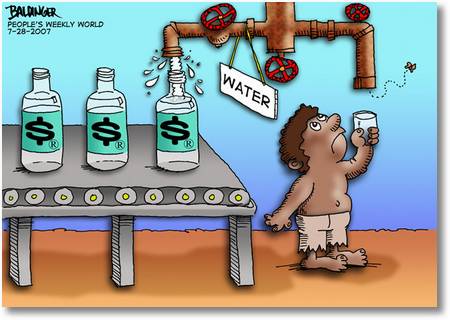The idea that paying for water is not new and whether or not water should be treated as commodities are widely debated.
Valuing Water
The valuation of water resources is often driven primarily by capitalistic production and accumulation dynamics. This often goes against the initial aim of the ecosystem services framework and risks leaving out alternative values of the system. This includes not only monetary values of water supply provision, but biophysical and ecological values provided by regulating and cultural services (Castro 2013). Short-term market considerations for water supply often overshadows multi-dimensional functions and services of the hydrological cycle as a whole.
Commodifying Water
While water should be a public good, there has been immense pressure to market and commodify water through water trading and privatisation as demand outstrips supply. This raises ethical questions on power relations and ultimately result in differential access to the provisioning service of water supply which were often a public good and available free of charge before water commodification (Walsh 2011). The commodification of water thus alters the supply of water and the availability of water to maintain other ecosystem services and environmental flows. An interesting example of this is wetland mitigation banking where ES produced by wetlands are sold as wetland credits by restoring pre-settlement wetland conditions. This marketization of previously public goods often bend to the will of capitalism in a bid to sell nature (Robertson 2003) without understanding integratively the underlying relationships between ecosystem functions and ecosystem service delivery.
In a Friends of the Earth investigative report on 'selling water and biodiversity', it was highlighted that bribes, underinvestment in infrastructure, unaffordable increase in water prices and poor water quality has been characteristics of water supply after privatization and commodification. In 1970s Nigeria, the water market was privatized after inadequate maintanence from the government and transformed water into a tradable commodity. General water supply provision declined as people were priced out of the water market with supply favouring rich communities, streams/rivers were continually polluted due to industrial development and private companies often fails to manage water sustainably and depletes aquifer and springs.
Commodifying Water
While water should be a public good, there has been immense pressure to market and commodify water through water trading and privatisation as demand outstrips supply. This raises ethical questions on power relations and ultimately result in differential access to the provisioning service of water supply which were often a public good and available free of charge before water commodification (Walsh 2011). The commodification of water thus alters the supply of water and the availability of water to maintain other ecosystem services and environmental flows. An interesting example of this is wetland mitigation banking where ES produced by wetlands are sold as wetland credits by restoring pre-settlement wetland conditions. This marketization of previously public goods often bend to the will of capitalism in a bid to sell nature (Robertson 2003) without understanding integratively the underlying relationships between ecosystem functions and ecosystem service delivery.
In a Friends of the Earth investigative report on 'selling water and biodiversity', it was highlighted that bribes, underinvestment in infrastructure, unaffordable increase in water prices and poor water quality has been characteristics of water supply after privatization and commodification. In 1970s Nigeria, the water market was privatized after inadequate maintanence from the government and transformed water into a tradable commodity. General water supply provision declined as people were priced out of the water market with supply favouring rich communities, streams/rivers were continually polluted due to industrial development and private companies often fails to manage water sustainably and depletes aquifer and springs.
I believe that using an ecosystem services framework to look at water supply would be beneficial only if attention is not paid predominantly on the economic and monetary valuation of services but instead to the fundamental biophysical and ecological concept of ecosystem functioning and services delivery (Schroter et.al. 2014). The inter-linked relationships within multiple elements of the hydrological cycle should be fully recognized for sustainable management to take place.







